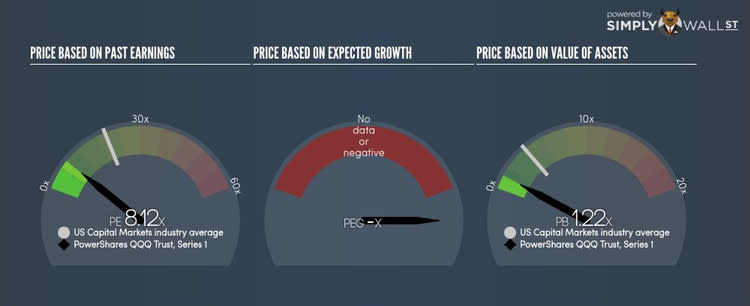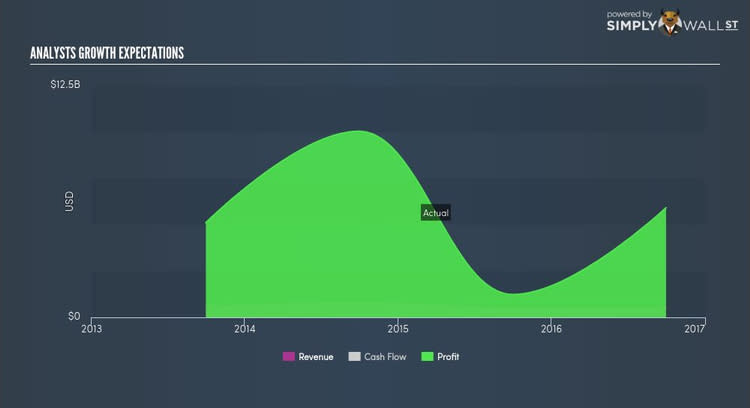Is PowerShares QQQ Trust Series 1 (QQQ) A Buy At Its Current Price?

PowerShares QQQ Trust Series 1 (NASDAQ:QQQ) is currently trading at a trailing P/E of 8.1x, which is lower than the industry average of 20.6x. While this makes QQQ appear like a great stock to buy, you might change your mind after I explain the assumptions behind the P/E ratio. Today, I will explain what the P/E ratio is as well as what you should look out for when using it. View our latest analysis for PowerShares QQQ Trust Series 1
What you need to know about the P/E ratio
The P/E ratio is a popular ratio used in relative valuation since earnings power is a key driver of investment value. By comparing a stock’s price per share to its earnings per share, we are able to see how much investors are paying for each dollar of the company’s earnings.
Formula
Price-Earnings Ratio = Price per share ÷ Earnings per share
P/E Calculation for QQQ
Price per share = 144.32
Earnings per share = 17.771
∴ Price-Earnings Ratio = 144.32 ÷ 17.771 = 8.1x
The P/E ratio itself doesn’t tell you a lot; however, it becomes very insightful when you compare it with other similar companies. Ideally, we want to compare the stock’s P/E ratio to the average of companies that have similar characteristics as QQQ, such as size and country of operation. One way of gathering a peer group is to use firms in the same industry, which is what I’ll do. Since similar companies should technically have similar P/E ratios, we can very quickly come to some conclusions about the stock if the ratios differ.
QQQ’s P/E of 8.1x is lower than its industry peers (20.6x), which implies that each dollar of QQQ’s earnings is being undervalued by investors. Therefore, according to this analysis, QQQ is an under-priced stock.
Assumptions to watch out for
Before you jump to the conclusion that QQQ represents the perfect buying opportunity, it is important to realise that our conclusion rests on two important assertions. The first is that our “similar companies” are actually similar to QQQ. If the companies aren’t similar, the difference in P/E might be a result of other factors. For example, if you accidentally compared higher growth firms with QQQ, then QQQ’s P/E would naturally be lower since investors would reward its peers’ higher growth with a higher price. Alternatively, if you inadvertently compared less risky firms with QQQ, QQQ’s P/E would again be lower since investors would reward its peers’ lower risk with a higher price as well. The second assumption that must hold true is that the stocks we are comparing QQQ to are fairly valued by the market. If this does not hold, there is a possibility that QQQ’s P/E is lower because firms in our peer group are being overvalued by the market.
What this means for you:
Are you a shareholder? If your personal research into the stock confirms what the P/E ratio is telling you, it might be a good time to add more of QQQ to your portfolio. But keep in mind that the usefulness of relative valuation depends on whether you are comfortable with making the assumptions I mentioned above.
Are you a potential investor? If you are considering investing in QQQ, basing your decision on the PE metric at one point in time is certainly not sufficient. I recommend you do additional analysis by looking at its intrinsic valuation and using other relative valuation ratios like PEG or EV/EBITDA.
PE is one aspect of your portfolio construction to consider when holding or entering into a stock. But it is certainly not the only factor. Take a look at our most recent infographic report on PowerShares QQQ Trust Series 1 for a more in-depth analysis of the stock to help you make a well-informed investment decision. Since we know a limitation of PE is it doesn't properly account for growth, you can use our free platform to see my list of stocks with a high growth potential and see if their PE is still reasonable.
To help readers see pass the short term volatility of the financial market, we aim to bring you a long-term focused research analysis purely driven by fundamental data. Note that our analysis does not factor in the latest price sensitive company announcements.
The author is an independent contributor and at the time of publication had no position in the stocks mentioned.


